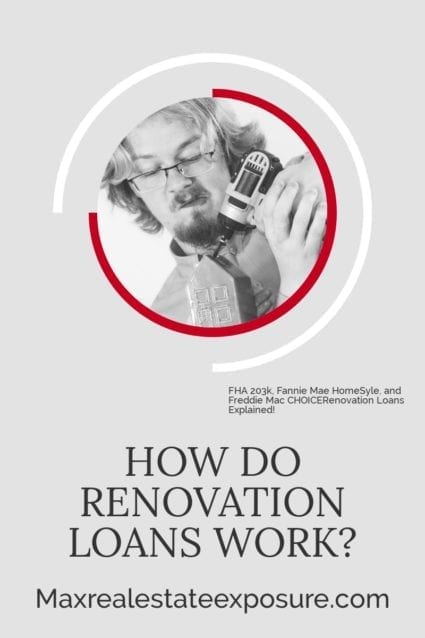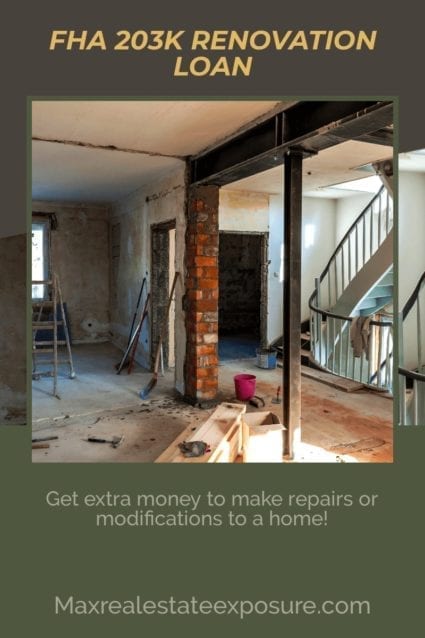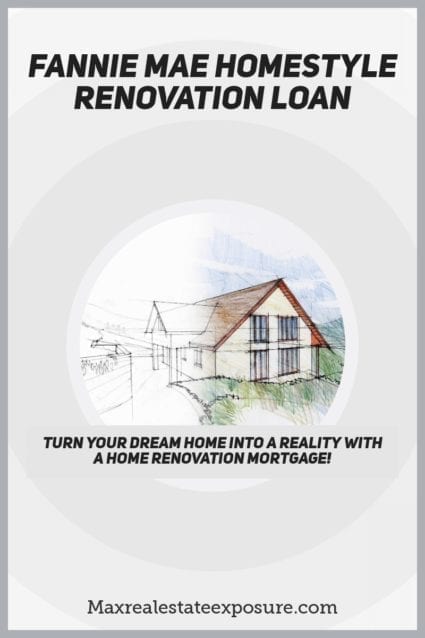What Are The Mortgage Options For Home Renovation Loans
 Are you looking for a home improvement loan? Do you know all the options for home renovation loans?
Are you looking for a home improvement loan? Do you know all the options for home renovation loans?
Over the years in my work for a mortgage company, I’ve been asked about the various options for home renovation mortgages numerous times.
Before tackling a significant financial decision, most people would like to know how home improvement loans work.
Having the right information gives you, the homeowner, or potential homeowner, the details needed to make an excellent decision for your current needs.
Home improvement loan programs can be a wonderful option when you’re purchasing a fixer-upper home. Buying a property that needs work is the perfect match for these types of loans. Doing your due diligence, however, is critical.
Whether you are getting a renovation mortgage or some other type of loan, for that matter, it’s essential to ask the lender questions. Getting the answers will help to determine which program and lender to choose.
Remember that each of the various types of home renovation mortgage loan programs will need different kinds of information to grant loan approval.
Here are what documents you need for each type of mortgage program.
Listed below are the top five home improvement loans and the specifics of each program. By the time you’re done reading, you’ll have a strong understanding of how renovation loans work.
What is a Home Improvement Loan?
Before we get into the specifics of each of the home improvement loans, let’s take about what is a renovation loan. As it sounds, a home improvement loan is a mortgage to make upgrades or additions to your home.
A home improvement loan could be either an unsecured loan or a secured loan, depending on what type of loan program you choose. An unsecured home improvement loan is when you don’t put up your house as an asset to loan against.
It’s not a traditional mortgage or a reverse mortgage. With an unsecured home improvement loan, you will not put your home at risk of loss.
Home improvement loans are typically paid back in regular monthly payments like other mortgage programs. Most home improvement loans are paid back over a three to five-year period.
Payments you make each month are the same as long as you pay on time and don’t accrue penalties or additional fees. The mortgage you qualify for will depend on your credit score, history, and ability to repay.
Most of the time, home improvement loans have fixed rates, keeping your payments consistent through the life of the loan.
Using A Home Equity Loan For Improvements
 Sometimes a borrower will use a home equity loan to finance whatever home improvements they would like to make to their property. A home equity loan taps the equity in your property.
Sometimes a borrower will use a home equity loan to finance whatever home improvements they would like to make to their property. A home equity loan taps the equity in your property.
Home equity loans are a mortgage for a fixed amount of money that is secured via your house.
Repayment of the loan is made with equal monthly payments, just like you are already making with your mortgage. If you don’t pay back the loan, the lender can foreclose on the property.
With home equity loans, you can typically borrow up to 85 percent of the equity in your home. The amount of money the lender will agree to lend will also be dependant on your credit, income, and the appraised value of the home.
The home equity mortgage is an excellent home improvement loan for projects such as remodeling a bath, kitchen, replacing a septic system, or adding a garage.
A HELOC Can Be Used in Place of Home Improvement Loans
A HELOC stands for a home equity line of credit. With a HELOC, you are using the equity in your home to secure a loan for home improvements.
While with a home equity loan, you get the total home improvement loan amount upfront, a HELOC will provide funds that you can draw on when needed.
The benefit of having a home equity line of credit is that you can use the loan for most things, including improving your home.
Since your home becomes collateral for the loan, you could put your home at risk of becoming a foreclosure if you default on the loan. The other downside of a HELOC is the interest rates are usually not fixed, so your payments can change at the drop of a hat.
Usually, there are caps on the interest rate going up, but an increase like that could put a strain on some folks financially.
A HELOC might not be the best home improvement loan option, especially if you are not on solid footing financially. Quite often, homeowners won’t be using a HELOC for improving their home but for some other reason.
Let’s take a look at the best renovation loan options when making significant improvements to your house. These home improvement loans are the most popular based upon each of their finer details.
These kinds of home improvement loans usually make far more sense than a HELOC.
Home Improvement Loan Options
Here are the types of home improvement loans we will be covering:
- FHA 203k Home Renovation Loan
- Homestyle Renovation Loan
- ChoiceRenovation Home Loan
- Homestyle Energy Mortgage
- VA Renovation Loan
FHA 203k Home Renovation Loan
One of the most popular home improvement loan options is the FHA 203K mortgage. As the name implies, this loan is similar to the FHA loans that have been around for many years and enabled people to become homeowners.
The same rules and guidelines used to approve people for an FHA loan are also used to approve borrowers for the FHA 203k loan.
This means that the mortgage rules will approve people with lower scores compared to conventional mortgages. Also, homebuyers can get approved with only a 3.5% down payment.
The 203k loan allows borrowers to get extra money to make repairs or modifications to a home. This allows a potential homebuyer to find a fixer-upper property and get enough funding to cover both the purchase price and the repairs.
The FHA 203K is one of the most popular home improvement loans.
How FHA 203K Home Renovation Loans Work
 First, a buyer will get pre-approved for the mortgage and then find a home. Next, they will consult with a local contractor to discuss the renovations and any necessary repairs.
First, a buyer will get pre-approved for the mortgage and then find a home. Next, they will consult with a local contractor to discuss the renovations and any necessary repairs.
The contractor will use this information to prepare a detailed estimate of the work to be performed.
The contractor will provide the estimate to the mortgage lender. The lender will give this information to the home appraiser.
The appraiser will make two appraisals of the home. The first appraisal determines the current market value of the house. The 2nd appraisal will assign a new value to the home based on the intended work by the contractor.
With the 2nd appraisal information, the lender can determine the final loan amount needed for the buyer.
The lender will then make one loan to the buyer. When the loan is created, the amount of money needed for the work done by the contractor will be held in an escrow account.
Like a construction loan for building a house – after work is completed and inspected, the funds will be released to the contractor.
This loan is available to prospective home buyers and people who currently own a home and wish to make some major renovations.
The loan is offered in two different forms. One loan, called the FHA 203k Streamline, has a cap on the total amount of money that can be used for the repairs and renovations made to the home, as well as specific restrictions about which kind of work can be performed.
The other loan, called the FHA 203k Standard, has fewer restrictions about the work and is only restricted by the borrower’s ability to repay the loan as well as the FHA maximum loan amounts for the area.
One question that comes up quite often is making payments while the home is being renovated. It is true that once the loan closes, the borrower will need to start making payments.
However, the Standard FHA 203k loan (not available for the FHA 203k Streamline version) will allow borrowers to get up to a total of 6 month’s worth of mortgage payments added to the total amount.
Basically, you would get extra money to cover the mortgage loan while living at another place during the renovations.
HomeStyle Renovation Loan
 The Homestyle loan is offered by Fannie Mae. This means that people who have qualified for a conventional mortgage loan may also qualify for this product. You are probably wondering how this home renovation loan works?
The Homestyle loan is offered by Fannie Mae. This means that people who have qualified for a conventional mortgage loan may also qualify for this product. You are probably wondering how this home renovation loan works?
The first difference between the typical conventional loan and the Homestyle loan is the down payment.
For Homestyle, a prospective buyer is asked to pay 3% down. The 3% is applied to the home’s current price added to the expected repair costs.
So, just for example, if the home is priced at $150,000 and the contractor estimate of repairs is $75,000, then the total would be $225,000. The buyer would be asked to pay 3% of $225,000 or $6,750.
This down payment only applies to people that are buying a home that will be their principal residence.
The Homestyle program also allows borrowers a hefty renovation budget if their income is sufficient to cover the proposed mortgage payment.
The actual rule states that a borrower can get either
- 75% of the expected repair price plus the home’s purchase price
- OR, 75% of the home’s expected new market value
The borrower will be allowed to get the lesser of the two items explained above. Let’s look at an example to clarify.
Suppose you have found a home that costs $190,000, and the necessary repairs and renovations come to $85,000. Using the 1st calculation above, $190,000 plus $85,000 equals $275,000. 75% of that amount is $206,250.
If the home is expected to be worth $320,000 after the repairs, 75% of $320,000 is $240,000. This would mean that you could proceed with the 85,000 dollars in repairs since the amount of $206,250 is lower than $240,000.
Like the FHA 203k loan, the Homestyle Renovation loan can be used to purchase a home as well as to refinance an existing home loan.
One major difference is that the Fannie Mae Homestyle loan can also be used with an investment property or a vacation home. However, there are restrictions on how much can be borrowed and how much can be used for the repairs.
Your local lender can give you details about the added restrictions for those kinds of properties. Keep in mind that every lender may have their own mortgage overlays too.
CHOICERenovation Loan
 Freddie Mac offers a renovation loan known as the CHOICERenovation loan, also called Choice Renovation. This loan is remarkably similar to the Homestyle loan provided by Fannie Mae.
Freddie Mac offers a renovation loan known as the CHOICERenovation loan, also called Choice Renovation. This loan is remarkably similar to the Homestyle loan provided by Fannie Mae.
The Choice Renovation loan has the same down payment guidelines as well as the loan to value rules offered by HomeStyle. It also follows similar credit rules, so this loan is intended for borrowers that qualify for conventional lending.
One aspect that is different about the Choice and Homestyle loans from the FHA loan is the allowance for building on an accessory unit.
Some people commonly refer to this as a mother-in-law addition. Whether the acquisition is for a family member or designed to be used for extra income in the form of Airbnb or VRBO, as long as the borrower qualifies for the loan, the construction of the addition can be approved.
Another difference that applies only to the Freddie Mac Choice loan is the disaster upgrades.
Over the last several years, thousands of homeowners have suffered either significant damage to their homes or an entire loss of property due to a wide range of natural disasters.
Flooding, wildfires, tornadoes, and hurricanes have struck in different areas and left homeowners with significant damages.
The new provision from Freddie Mac allows homeowners to finance items like retaining walls to combat floods, surge barriers, and even retrofitting the foundation with reinforcements.
These significant upgrades can provide a measure of resistance against a natural disaster and provide homeowners with the peace of mind that their home will survive an unforeseen event.
The Choice Renovation loan can be used with a single-unit investment home if the borrower is willing to pay 15% down. The higher down payment reflects the higher risk associated with purchasing an investment home compared to buying a primary residence.
For both the Choice Renovation loan and the Homestyle loan, the repairs or improvements made to the home have to be finished within 12 calendar months after closing the loan.
HomeStyle Energy Mortgage
Fannie Mae offers another program called the Homestyle Energy Mortgage that allows borrowers to get extra funds for improvements. However, these improvements must be designated as items that will specifically improve the home’s overall energy efficiency. The Homestyle Energy Mortgage is one of the more unique home improvement loan options.
Like the other renovation programs, this loan allows a low down payment option of only 5%. The down payment amount is based on the home’s value after the improvements are made.
Consider the following example. A married couple is considering a home priced at $150,000. The suggested improvements to the home cost $12,000. Based on comparable homes in the area, the improvements will raise the home’s value to $168,000. Thus, the couple would be asked to pay $8,400 down at time of closing ($168,000 x 5% = $8,400).
The HomeStyle Energy mortgage is an excellent way for homebuyers to get the funds needed to purchase a home and also improve the home’s overall efficiency. Examples of efficiency improvements include
- New heating and ventilation system, also called HVAC
- More energy-efficient doors and windows
- Improved insulation in the roof
- Weatherization improvements around windows, doors, and roof edges
- Improved water heaters
Buyers may also use the funds for renewable energy improvements. These improvements help reduce the impact on the environment while also lowering utility costs for the homeowner. Examples of renewable energy include
- Wind power sources
- Solar panels for gathering energy
- Geothermal energy source
There are restrictions on the loan amount for a HomeStyle Energy mortgage. The most that a borrower may use for the home improvements is 15% of the improved worth of the home. So, going back to the earlier example of a house that would be worth $168,000 after the improvements, the maximum amount that could be used for work on the property would be $25,200.
Like the other renovation programs mentioned earlier in this article, the Homestyle Energy loan can be used to purchase a home or refinance an existing mortgage.
Using a HomeStyle Energy Mortgage is an excellent renovation loan option when you would like to go green!Click To TweetVA Home Renovation Loan
 The Veterans Administration also offers a loan that will allow borrowers to get extra money to make renovations to an existing home. Their product is called the VA Renovation Loan, and it has some similarities to the other products previously mentioned.
The Veterans Administration also offers a loan that will allow borrowers to get extra money to make renovations to an existing home. Their product is called the VA Renovation Loan, and it has some similarities to the other products previously mentioned.
First and foremost, borrowers must meet the military service requirement in order to be eligible for this loan, along with the credit and income guidelines.
If you have served or are serving in the military, a VA renovation mortgage could be an excellent home improvement loan option.
Next, the VA has a different method for determining the loan amount for qualified borrowers. The VA will finance the lessor of
- Cost to buy and repair the home
- The appraised value of the property.
For example, suppose a qualified veteran is looking to purchase a home that is priced at $125,000 but needs $45,000 in repairs. The purchase price plus the repairs, plus a contingency, would be $175,000.
If the home is appraised to be worth $171,000 after all repairs, the borrower would be asked to pay the $4,000 difference out of their own pocket. But if the home is considered to be worth $178,000 after repairs, then the borrower can finance the purchase price plus the repair costs and the contingency.
The VA renovation loan does not require a minimum amount for improvements and repairs to a home. So long as the borrower qualifies for the loan, the VA will accept it.
The VA also has some restrictions on the type of work that can be completed on the property. With the FHA 203k loan and the Fannie Mae Homestyle loan, borrowers have a lot of leeway in choosing the type of improvements and repairs that can be made to the home.
The VA loan is designed for making necessary repairs, such as fixing a faulty roof or replacing an outdated HVAC system. It is not intended for making the living room more modern with new floor covering and a better paint job.
The VA loan also requests that a contractor approved by the VA be the one in charge of making necessary repairs and or improvements. This may limit the available pool of qualified contractors in your area, so it is best to check with your lender before choosing the contractor for your home.
The lender has the responsibility of following up with the contractor, scheduling inspections, and ensuring the work has been completed based on the local construction codes. The lender will use an inspector approved by the VA to review the home after all work is finished and ensure that the home meets the minimum requirements. Once the work is done and inspected, the funds will be released to the contractor.
Be sure to read up on VA mortgage facts, as many myths are surrounding the program. If you have served or are presently serving in the military, there are numerous benefits for using VA financing.
Another thing to keep in mind is that both standard VA and FHA loans have property condition requirements. These go away, however, when you are using home renovation loans.
Where to Get Home Improvement Loans
 As you can see from what we have covered, there are numerous options for home improvement loans.
As you can see from what we have covered, there are numerous options for home improvement loans.
When seeking out where to get a home improvement loan, you can first start with whoever holds your mortgage. They might be one of the better options.
It is always worth it to shop rates and terms, though, so look around for some local lenders or even speaking with a mortgage broker.
There will be plenty of lenders who will gladly give a home improvement loan as long as you qualify for one.
You could also do an online search as well for home improvement loans near me. Doing this search should provide you with a few lending options.
Like other mortgage programs, home improvement loan rates can vary so it pays to shop around.
Best Home Improvement Loans For Bad Credit
If you have bad credit, getting a home improvement loan will be far more challenging. According to Nerd Wallet, however, some lenders specifically deal with home improvement loans for bad credit. These are the companies you will want to speak with:
- Upgrade
- Avant
- OneMain Financial
- Upstart
- Lending Club
When you have bad credit, you can expect that the rates on these home improvement loans will be higher and, in some cases, much higher.
Home improvement loan rates can vary even when you don’t have bad credit.
Refinance Instead of a Home Renovation Loan
One last option is to refinance your house instead of doing a home improvement loan. This could be a better option if interest rates have been dropping and you have not refinanced yet. If you qualify, you could increase your mortgage amount by the amount needed for your renovation.
You will be taking advantage of lower interest rates while at the same time getting money to make your home improvements. In this scenario, refinancing could be a better situation than getting a separate home improvement loan.
Summing Up How Home Improvement Loans Work
Thanks to improvements made in the overall mortgage industry, borrowers now have more choices regarding home renovation loans. If you are a first-time home buyer, there are even more mortgage programs worth investigating.
The ability to get one loan, with one closing and pay a low single interest rate on the entire amount, is a massive benefit to both people that wish to buy and renovate a home as well as for existing homeowners.
Hopefully, you now have a much better understanding of all the home improvement loan options available to homeowners.
Additional Home Buyer Resources:
- Refinancing your home improvements – learn what you need to know about refinancing your mortgage for making home improvements around your property. Get more valuable information on home improvement loans.
- Things to consider before buying a home – Purchasing a home for the first time is a big deal. You want to avoid the common mistakes that plague many first-timers. Have a look at some terrific advice on what to think about before buying a home.
- Why Buyers Fail To Get Approved For A Mortgage – Nobody wants to be turned down for a mortgage, but do you know why it happens? See what you need to do to avoid getting a big fat rejection letter.
- How To Avoid Home Buyer’s Remorse – When purchasing a house, no party wants to be in the middle of a transaction only to find out the buyer has had a change of heart. If you are going to be buying a home, make sure you have thought through your purchase decision well.
Use the above real estate resources to make excellent decisions when buying your next home.
 About the author: The above article on what are home improvement loans and the best home renovation loan options was written by Luke Skar of Madison Mortgage Guys.
About the author: The above article on what are home improvement loans and the best home renovation loan options was written by Luke Skar of Madison Mortgage Guys.
Luke serves as the Social Media Strategist for Madison Mortgage Guys. His role is to provide original content for all of their social media profiles as well as generating new leads from his website.